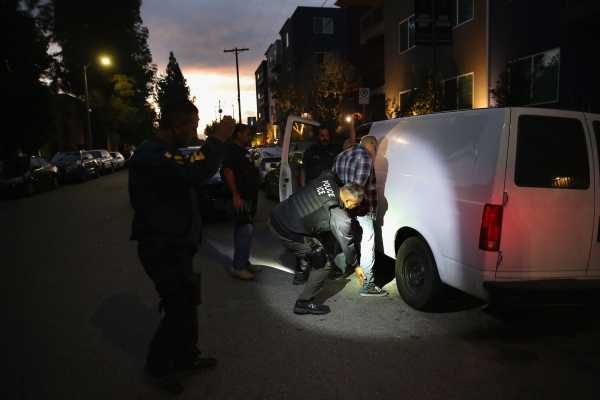
Before President Donald Trump, only immigrants and their neighbors were likely to know what the acronym ICE stands for: Immigration and Customs Enforcement, the agency tasked with identifying, detaining, and deporting people in the US who have violated immigration law.
Under Trump, it’s become a household name — even in the households that don’t have to worry about its agents knocking on their doors.
As the people on the ground carrying out Trump’s deportation agenda, ICE agents have become, to many, the face of the administration’s worst impulses. They’re America’s “Gestapo.” They’re a “rogue agency.” Rumors and reports of ICE raids have rippled through communities and social media with regularity; arrests of parents, recorded on their children’s cellphone cameras, have provoked nationwide outrage.
The problem for progressives isn’t just that ICE is part of the Trump administration. Increasingly, they are opposed to the idea of the agency itself.
“It’s time,” wrote Sean McElwee in the Nation recently, “to abolish ICE.”
Resistance to ICE and to deportation isn’t new. Immigrant groups have been fighting the expansion of immigration enforcement for years.
But as the prospects dim for any congressional deal to address the status of the Deferred Action for Childhood Arrivals (DACA) program and the hundreds of thousands of young undocumented immigrants who depend on it, activists see it as even more important to push back against aggressive immigration enforcement. Leading DC-based immigrant rights groups, including United We Dream, are currently urging members of Congress to refuse to appropriate any money to enforce Trump’s agenda.
What McElwee is pushing, and has turned into something of a meme on segments of the left, seems more radical than just cutting funding for the agency. It has the virtue of seeming, to progressives, like the sort of Big Thinking that conservatives engage in and Democrats often don’t. In practice, it’s a slogan that encompasses both incremental proposals (like cutting funding for deportations) and radical ones like abolishing deportation itself — something that not everyone using “abolish ICE” as a Twitter hashtag necessarily agrees with.
At the moment, the idea of abolishing ICE is exactly prominent enough for MSNBC’s Chris Hayes to ask Sen. Kamala Harris (D-CA), arguably the most progressive member of the Senate on immigration, if she supports it. But it is not prominent enough for Harris (often mentioned as a contender for the presidential nomination in 2020) to consider the idea; she defended the need for ICE as an agency, even if she disapproved of what it did under President Trump.
But it’s probably not going to be the last time Harris and other national politicians are asked the question. Progressives are increasingly frustrated by a longstanding truth: The Democratic Party has often been a willing partner in building up the immigration enforcement apparatus that Trump has now taken advantage of.
The longer that progressives see what Trump is doing with ICE, the more questions they might have about whether it’s a good idea for any president to have that kind of power — and the more likely they might be to ask those questions of anyone who wants to be the Democratic Party’s nominee in 2020.
Deportation isn’t new. But ICE has made it a broad and serious threat.
ICE’s primary mission is to enforce immigration law within the interior of the United States — in other words, immigration enforcement that isn’t primarily about stopping or catching people trying to enter the US.
In practice, that often means sending people who have lived in the US for years back to countries they haven’t seen in at least that long. Sometimes it means splitting up families or forcing US-born children to move to an unfamiliar country to keep the family together. Sometimes, it means putting people in lethal danger.
“Deportation is brutal,” McElwee told Vox in an interview. “It is probably the worst thing the government can do to you, next to death, and maybe even worse than that.”
To be in the United States without legal immigration status is to be subject to potential deportation. That’s been a truth of immigration law forever.
It’s just that for most of US history, it was mostly a hypothetical truth. The federal government just didn’t have the resources for interior immigration enforcement to pick up and remove large numbers of immigrants who hadn’t committed other crimes. (Not to mention that it’s pretty new for the US to have a large and permanent population of unauthorized immigrants.)
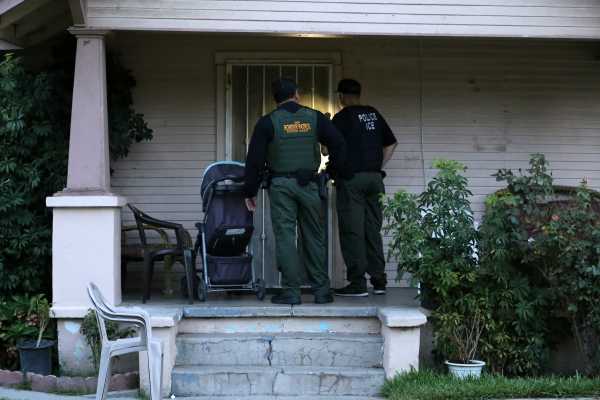

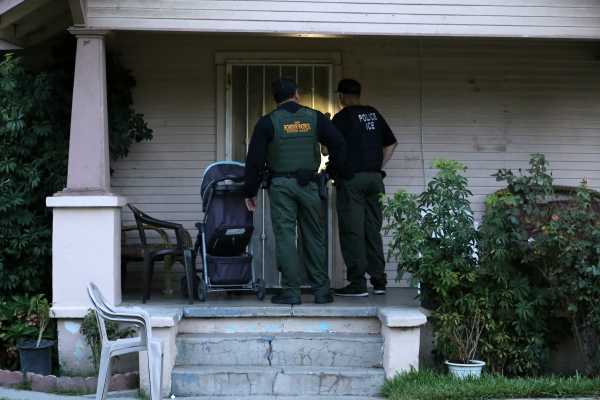
A single agency, the Immigration and Naturalization Service (INS, established in 1933), was responsible for overseeing both legal immigration and enforcement against unauthorized immigration — both at the border and ports of entry and in the interior of the United States.
“The idea of deporting was definitely part of the mission of the agency,” says former INS Commissioner Doris Meissner (who served under Clinton). But “there were far less resources then, and so the question was always how do you use those resources.”
After 9/11, the federal immigration bureaucracy was rehoused in the brand new Department of Homeland Security (DHS). And it was split into three separate agencies: Legal immigration processing went to US Citizenship and Immigration Services, border enforcement went to Customs and Border Protection, and interior enforcement went to ICE.
“It was very much the intent of the Congress, in creating DHS, to set up a structure where the enforcement agencies, both CBP and ICE, would really be able to maximize their missions by focusing solely on their mission,” says Meissner.
So in the 2000s, the US started deporting more immigrants than it ever had before. And for the first time, a large number of those deported were unauthorized immigrants with no criminal record, who were deported just because they were unauthorized. For the first time, in other words, simply being an immigrant without papers in the US carried a real risk of deportation.
The Trump administration has worked hard to downplay this history, but it’s worth remembering that it was under President Obama that the US reached its high-water mark for immigration enforcement. By pretty much any quantitative measure — arrests, deportations, the share of all deportees who had no criminal record — any year of Obama’s first term saw more aggressive immigration enforcement than Trump’s first year.
But because ICE was being run by a Democrat — one who had promised to legalize unauthorized immigrants — many progressives didn’t pay much attention at the time. And, more important, the policy was packaged very differently: The administration itself downplayed the aggressiveness of its tactics. It spent most of its time promising that ICE was going after “felons, not families” — though it wasn’t until November 2014, when a DHS memo set restrictive guidelines on when ICE could arrest unauthorized immigrants, that “felons, not families” became more or less a reality.
Objectively, the Trump immigration agenda — “unshackling” ICE agents and reiterating that every unauthorized immigrant “should be worried” about getting deported — is a reinstatement of the status quo during Obama’s first term. But because it’s a change from a period of relative safety — deportations did go down in the final years of the Obama administration — and because of Trump’s anti-immigrant rhetoric, it feels like something new.
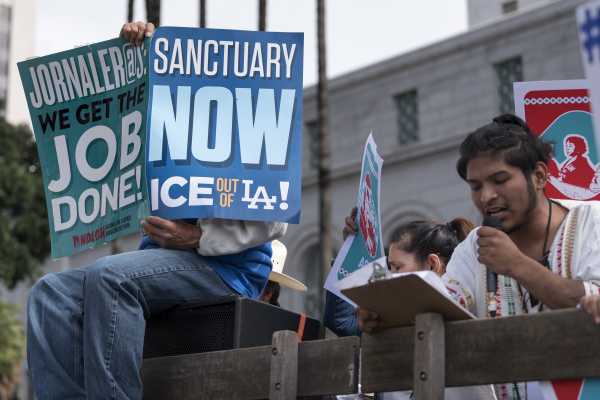

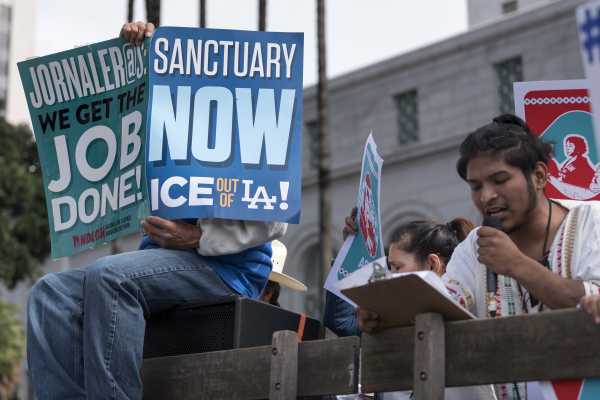
What “abolish ICE” actually means
McElwee, a freelance writer, took up the effort in 2017 to turn “abolish ICE” into a core demand of the left. If you’ve seen the idea proposed or debated lately, it’s probably a result of McElwee’s efforts.
“I see the really, really progressive people running for office” in the Trump era, he says, “and see the opportunity for those candidates to differentiate themselves in Democratic primaries — and to shift the Overton window on deportation policy.” (The Overton window is a concept from political science; it refers to the scope of policy ideas that are considered realistic.)
“We’re doing what the GOP has so successfully accomplished with its policy priorities,” McElwee says, “which is taking an institution and making it hated.” Conservatives calling for the abolition of the IRS or the Consumer Financial Protection Bureau haven’t gotten either agency abolished; they have, however, gotten Republicans in government to take opportunities to weaken the agencies by cutting their funding, narrowing their mandate, and increasing scrutiny.
As Congress nears another spending deadline, activists are pushing a plan B demand: If Congress can’t agree to legalize DREAMers, congressional Democrats should at least cut funds to the agencies that would be detaining and deporting them.
“This is a battleground issue,” says Greisa Martinez, advocacy director for United We Dream, the leading advocacy network among young unauthorized immigrants. “You’ve seen how unchecked ICE and CBP agents are in our communities. … It’s the responsibility of Democrats and Republicans of Congress to hold them accountable and not give them more money.”
The group’s #DefundHate campaign isn’t explicitly about abolishing ICE as an agency. “At this moment, United We Dream is focused on protecting people from deportation,” Martinez says. She sees the abolition of ICE as part of a conversation about the “long-term vision that people are safe in their families and communities.”
But McElwee sees it as essentially the same push: to weaken federal immigration enforcement directly, through targeting the resources the executive branch has to detain and deport people.
“Abolish ICE” is a challenge for Democrats
Trump sees rank-and-file law enforcement officers as his natural allies in a culture war. Progressives have responded in kind: by targeting not just the Trump administration officials appointed to run immigration enforcement but ICE agents themselves, whom they have cast as moral monsters whose power needs to be drastically curtailed or destroyed.
This conflicts with the Democrats’ traditional message, which is something akin to “don’t hate the player, hate the game” — in other words, the problem with immigration policy is not the agents but the laws that keep 11 million people in the shadows.
“The men and women at ICE are, by and large, overwhelmingly good people who are following the directives given them by the elected leadership, and just got into this business because they want to make this country a little bit safer,” says John Sandweg, who briefly led ICE under Obama. “They’re the ones who get screwed in this entire debate” because their job happens to be the enforcement of unpopular laws.
McElwee does not see it that way. “If you become an immigration enforcement officer, you’re doing that because you want to deport people,” he says. “There’s no other reason.” And so ICE is “an apparatus that has a lot of people in it who are pretty committed to the idea of what I would call ethnic cleansing.”
Other progressives might not go as far as McElwee, but they’re increasingly hating the player, not the game.
And the very idea of deportation has been called into question. “It should be a contested question as to whether [deportation] is a legitimate thing that governments should do,” McElwee says.
He may very well not be alone. The Democratic base seems to be losing its appetite for the Obama-era “felons, not families” frame. Immigrant activists have long criticized this message for drawing a false distinction between “good” and “bad” immigrants — and have pointed out simply having a criminal record doesn’t mean one isn’t also the victim of discriminatory enforcement.
Immigration hawks have greeted the rise of the “abolish ICE” meme with barely restrained glee. For years, they’ve suspected that many progressives actually oppose all enforcement of immigration law and are just too chicken to come out as supporters of open borders. An effort to “abolish ICE,” and to paint anyone involved in deportation as a bad person, strikes the hawks as a revealing of the left’s true colors — the sort of thing that Democrats have spent years carefully trying not to imply.
McElwee doesn’t expect Democrats to start calling for an end to deportations permanently — he describes it as a “30-year” goal. But he does expect to help push the Overton window far enough to the left that the Obama administration’s position, of a fully matured but targeted ICE regime, is seen as the center-right position — and Democrats embrace a new center left.
Of course, what that “new center left” actually is won’t be relevant until a Democrat is running ICE again — and it might not even be something anyone bothers to articulate in the meantime. A former Obama DHS official worries that the “abolish ICE” campaign will wind up the same way the conservative abolish-the-IRS push has: with a “‘dog that caught the car’ problem,” as a party used to bashing a federal agency struggles to run it competently.
This doesn’t mean the activists rallying to abolish ICE are supposed to present a 20-page memo for what they think immigration enforcement ought to be. But the Democratic Party will at some point have to do just that. They’ll have to decide whether they believe deportation of unauthorized immigrants is a business that government ought to be engaged in and whether the people engaged in that business now are good people following orders or bad people who need to be stripped of power.
For now, it’s easy for progressives like Kamala Harris to settle on the “moderate” side of those questions — to defend ICE’s existence even as she decries its actions under Trump. But if the abolition of ICE becomes not just a left hobbyhorse but a core part of what progressives will ask of their candidates for 2020, that’s going to be a harder choice for Democratic politicians to make.
Sourse: vox.com






